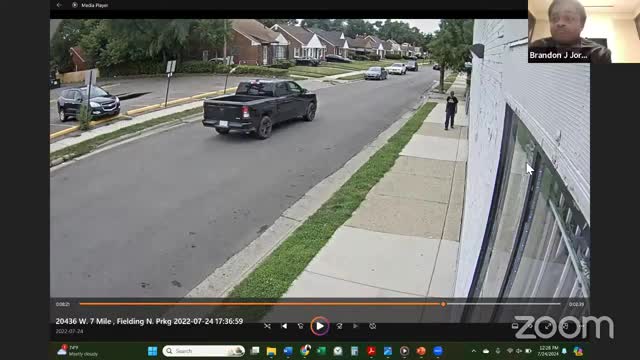Investigation under fire as key evidence goes missing
July 24, 2024 | CTRM 234 36th District Court, District Court Judges, Judicial, Texas

This article was created by AI summarizing key points discussed. AI makes mistakes, so for full details and context, please refer to the video of the full meeting. Please report any errors so we can fix them. Report an error »

In a recent government meeting, significant discussions emerged regarding the investigation of a first-degree murder case that occurred on July 24, 2022. The focus was on the investigative procedures followed by law enforcement, particularly concerning the enhancement of video footage and the collection of evidence.
During the meeting, an officer involved in the investigation detailed attempts to enhance video footage from a gas station to identify a suspect's vehicle. Despite efforts from multiple colleagues and external resources, the officer admitted that they were unable to extract a usable license plate from the footage. The officer confirmed that while they had received numerous inquiries from the victim's family about the case, they did not conduct any interviews with family members, which raised questions about the thoroughness of the investigation.
The timeline of evidence collection was also scrutinized, particularly the delay in requesting additional video footage from the gas station, which occurred more than a month after the incident. The officer acknowledged viewing footage from the day before the shooting but stated that it did not yield any valuable information, leading to no preservation of that footage.
The investigation's handling of potential witnesses was another focal point. The officer conducted a canvass of nearby businesses, including Happy's Pizza, but did not document any witness statements, claiming that those spoken to had no relevant information. This lack of documentation was criticized, especially given the seriousness of the case.
Additionally, the officer discussed the use of a Google geofence to identify devices in the vicinity of the shooting. While five devices were located within the geofence, the officer admitted that follow-up attempts to contact the device owners were unsuccessful, and no further investigation was conducted to determine their relevance to the case.
The officer also addressed interactions with a key individual, Sean Clark, who was reportedly one of the last people to see the victim. Although the officer interviewed Clark twice, neither interview was recorded or preserved, raising concerns about the integrity of the investigative process.
Overall, the meeting highlighted critical gaps in the investigative procedures, particularly regarding evidence preservation and witness interviews, which could have implications for the ongoing legal proceedings related to the case. The discussions underscored the importance of thorough documentation and follow-up in homicide investigations to ensure justice is served.
During the meeting, an officer involved in the investigation detailed attempts to enhance video footage from a gas station to identify a suspect's vehicle. Despite efforts from multiple colleagues and external resources, the officer admitted that they were unable to extract a usable license plate from the footage. The officer confirmed that while they had received numerous inquiries from the victim's family about the case, they did not conduct any interviews with family members, which raised questions about the thoroughness of the investigation.
The timeline of evidence collection was also scrutinized, particularly the delay in requesting additional video footage from the gas station, which occurred more than a month after the incident. The officer acknowledged viewing footage from the day before the shooting but stated that it did not yield any valuable information, leading to no preservation of that footage.
The investigation's handling of potential witnesses was another focal point. The officer conducted a canvass of nearby businesses, including Happy's Pizza, but did not document any witness statements, claiming that those spoken to had no relevant information. This lack of documentation was criticized, especially given the seriousness of the case.
Additionally, the officer discussed the use of a Google geofence to identify devices in the vicinity of the shooting. While five devices were located within the geofence, the officer admitted that follow-up attempts to contact the device owners were unsuccessful, and no further investigation was conducted to determine their relevance to the case.
The officer also addressed interactions with a key individual, Sean Clark, who was reportedly one of the last people to see the victim. Although the officer interviewed Clark twice, neither interview was recorded or preserved, raising concerns about the integrity of the investigative process.
Overall, the meeting highlighted critical gaps in the investigative procedures, particularly regarding evidence preservation and witness interviews, which could have implications for the ongoing legal proceedings related to the case. The discussions underscored the importance of thorough documentation and follow-up in homicide investigations to ensure justice is served.
View full meeting
This article is based on a recent meeting—watch the full video and explore the complete transcript for deeper insights into the discussion.
View full meeting
